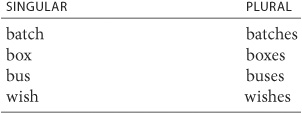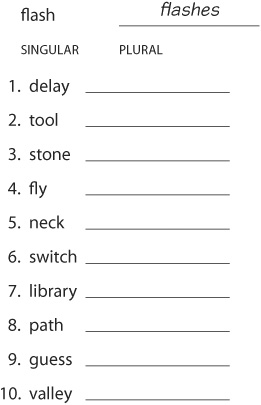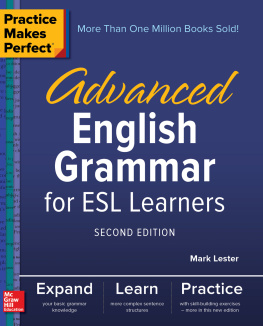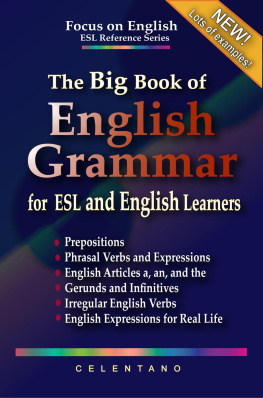PRACTICE MAKES PERFECT
Advanced English Grammar for ESL Learners
PRACTICE MAKES PERFECT Advanced English Grammar for ESL Learners
Mark Lester

Copyright 2011 by The McGraw-Hill Companies, Inc. All rights reserved. Printed in the United States of America. Except as permitted under the United States Copyright Act of 1976, no part of this publication may be reproduced or distributed in any form or by any means, or stored in a database or retrieval system, without the prior written permission of the publisher. ISBN: 978-0-07-174333-4 MHID: 0-07-174333-2 The material in this eBook also appears in the print version of this title: ISBN: 978-0-07-159879-8, MHID: 0-07-159879-0. All trademarks are trademarks of their respective owners.
Rather than put a trademark symbol after every occurrence of a trademarked name, we use names in an editorial fashion only, and to the benefit of the trademark owner, with no intention of infringement of the trademark. Where such designations appear in this book, they have been printed with initial caps. McGraw-Hill eBooks are available at special quantity discounts to use as premiums and sales promotions, or for use in corporate training programs. To contact a representative please e-mail us at bulksales@mcgraw-hill.com. Trademarks: McGraw-Hill, the McGraw-Hill Publishing logo, Practice Makes Perfect, and related trade dress are trademarks or registered trademarks of The McGraw-Hill Companies and/or its affiliates in the United States and other countries and may not be used without written permission. All other trademarks are the property of their respective owners.
The McGraw-Hill Companies is not associated with any product or vendor mentioned in this book. TERMS OF USE This is a copyrighted work and The McGraw-Hill Companies, Inc. (McGraw-Hill) and its licensors reserve all rights in and to the work. Use of this work is subject to these terms. Except as permitted under the Copyright Act of 1976 and the right to store and retrieve one copy of the work, you may not decompile, disassemble, reverse engineer, reproduce, modify, create derivative works based upon, transmit, distribute, disseminate, sell, publish or sublicense the work or any part of it without McGraw-Hills prior consent. You may use the work for your own noncommercial and personal use; any other use of the work is strictly prohibited.
Your right to use the work may be terminated if you fail to comply with these terms. THE WORK IS PROVIDED AS IS. McGRAW-HILL AND ITS LICENSORS MAKE NO GUARANTEES OR WARRANTIES AS TO THE ACCURACY, ADEQUACY OR COMPLETENESS OF OR RESULTS TO BE OBTAINED FROM USING THE WORK, INCLUDING ANY INFORMATION THAT CAN BE ACCESSED THROUGH THE WORK VIA HYPERLINK OR OTHERWISE, AND EXPRESSLY DISCLAIM ANY WARRANTY, EXPRESS OR IMPLIED, INCLUDING BUT NOT LIMITED TO IMPLIED WARRANTIES OF MERCHANTABILITY OR FITNESS FOR A PARTICULAR PURPOSE. McGraw-Hill and its licensors do not warrant or guarantee that the functions contained in the work will meet your requirements or that its operation will be uninterrupted or error free. Neither McGraw-Hill nor its licensors shall be liable to you or anyone else for any inaccuracy, error or omission, regardless of cause, in the work or for any damages resulting there from. McGraw-Hill has no responsibility for the content of any information accessed through the work.
Under no circumstances shall McGraw-Hill and/or its licensors be liable for any indirect, incidental, special, punitive, consequential or similar damages that result from the use of or inability to use the work, even if any of them has been advised of the possibility of such damages. This limitation of liability shall apply to any claim or cause whatsoever whether such claim or cause arises in contract, tort or otherwise.
Contents
Preface
Practice Makes Perfect: Advanced English Grammar for ESL Learners is designed to help advanced-level learners gain control over difficult areas of English grammar. This book is not a systematic treatment of all areas of English grammar. Instead, it deals in depth with selected grammar topics that pose special problems for nonnative speakers. These topics fall into two areas: (1) areas of grammar that are the source of persistent error and (2) areas of grammar that are so complex that even advanced nonnative speakers almost always avoid them.
Examples of the first type of persistent error would be using wrong articles, misusing the present and present progressive tenses, confusing present and past participles of verbs used as adjectives, and using the wrong relative pronoun in adjective clauses. Examples of the second type of constructions that are avoided because of their complexity would be gerunds and infinitives used as nouns, participial phrases, and wh- infinitive phrases. Each topic is explained in detail, often going far beyond what would be found in a more general grammar book. My hope is that by fully understanding the technical grammatical issues involved, you will feel much more confident in using these difficult constructions. Each bit of grammatical analysis is supported by a series of practice exercises that will help you gain practical control over the issues covered in the analysis.
The spelling and pronunciations of regular nouns
Spelling
Most regular nouns form their plural spelling by adding -
s to the singular form.
The spelling and pronunciations of regular nouns
Spelling
Most regular nouns form their plural spelling by adding -
s to the singular form.
For example:  If the regular plural is pronounced as a separate syllable rhyming with fizz, the regular plural is spelled -es. For example:
If the regular plural is pronounced as a separate syllable rhyming with fizz, the regular plural is spelled -es. For example:  There is a special spelling rule for the plural of words that end in a consonant + y: change the y to i and add -es. For example:
There is a special spelling rule for the plural of words that end in a consonant + y: change the y to i and add -es. For example:  However, if the y follows a vowel, the y is part of the spelling of the vowel and cannot be changed. For example:
However, if the y follows a vowel, the y is part of the spelling of the vowel and cannot be changed. For example:  EXERCISE 1.1Write the correct form of the plural in the second column. The first question is done as an example.
EXERCISE 1.1Write the correct form of the plural in the second column. The first question is done as an example.
Pronunciation
The regular plural has three different pronunciations: /s/, /z/, and /z/ (rhymes with
fizz). Which one we use is totally governed by the sound that immediately precedes it according to the following three rules: If the singular noun ends in a voiceless consonant sound (except a voiceless sibilant sound like the
s in
bus or
Next page






 Copyright 2011 by The McGraw-Hill Companies, Inc. All rights reserved. Printed in the United States of America. Except as permitted under the United States Copyright Act of 1976, no part of this publication may be reproduced or distributed in any form or by any means, or stored in a database or retrieval system, without the prior written permission of the publisher. ISBN: 978-0-07-174333-4 MHID: 0-07-174333-2 The material in this eBook also appears in the print version of this title: ISBN: 978-0-07-159879-8, MHID: 0-07-159879-0. All trademarks are trademarks of their respective owners.
Copyright 2011 by The McGraw-Hill Companies, Inc. All rights reserved. Printed in the United States of America. Except as permitted under the United States Copyright Act of 1976, no part of this publication may be reproduced or distributed in any form or by any means, or stored in a database or retrieval system, without the prior written permission of the publisher. ISBN: 978-0-07-174333-4 MHID: 0-07-174333-2 The material in this eBook also appears in the print version of this title: ISBN: 978-0-07-159879-8, MHID: 0-07-159879-0. All trademarks are trademarks of their respective owners.  If the regular plural is pronounced as a separate syllable rhyming with fizz, the regular plural is spelled -es. For example:
If the regular plural is pronounced as a separate syllable rhyming with fizz, the regular plural is spelled -es. For example:  There is a special spelling rule for the plural of words that end in a consonant + y: change the y to i and add -es. For example:
There is a special spelling rule for the plural of words that end in a consonant + y: change the y to i and add -es. For example:  However, if the y follows a vowel, the y is part of the spelling of the vowel and cannot be changed. For example:
However, if the y follows a vowel, the y is part of the spelling of the vowel and cannot be changed. For example:  EXERCISE 1.1Write the correct form of the plural in the second column. The first question is done as an example.
EXERCISE 1.1Write the correct form of the plural in the second column. The first question is done as an example.